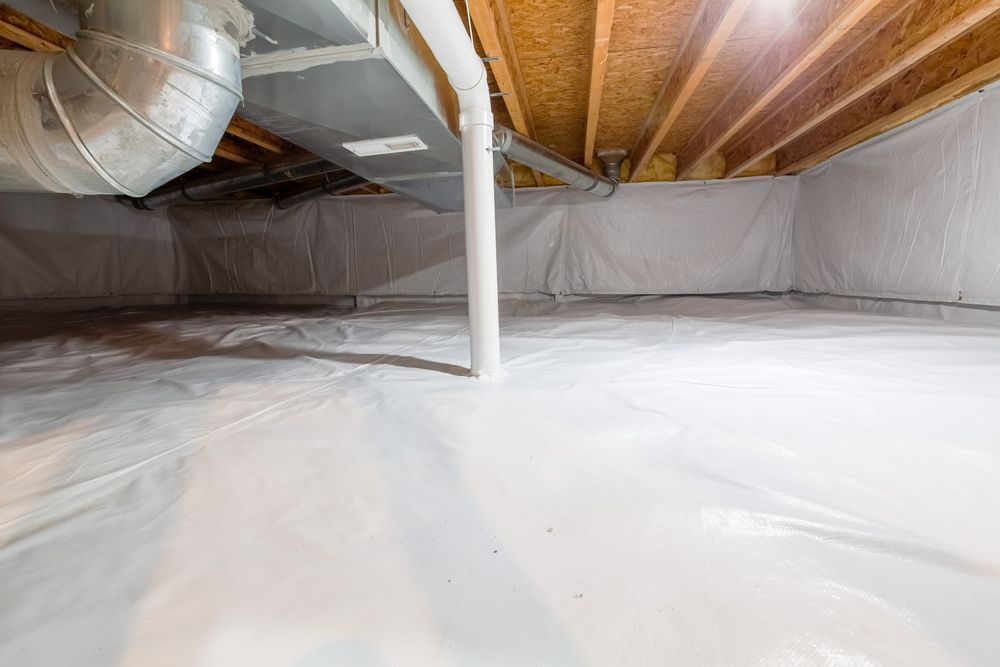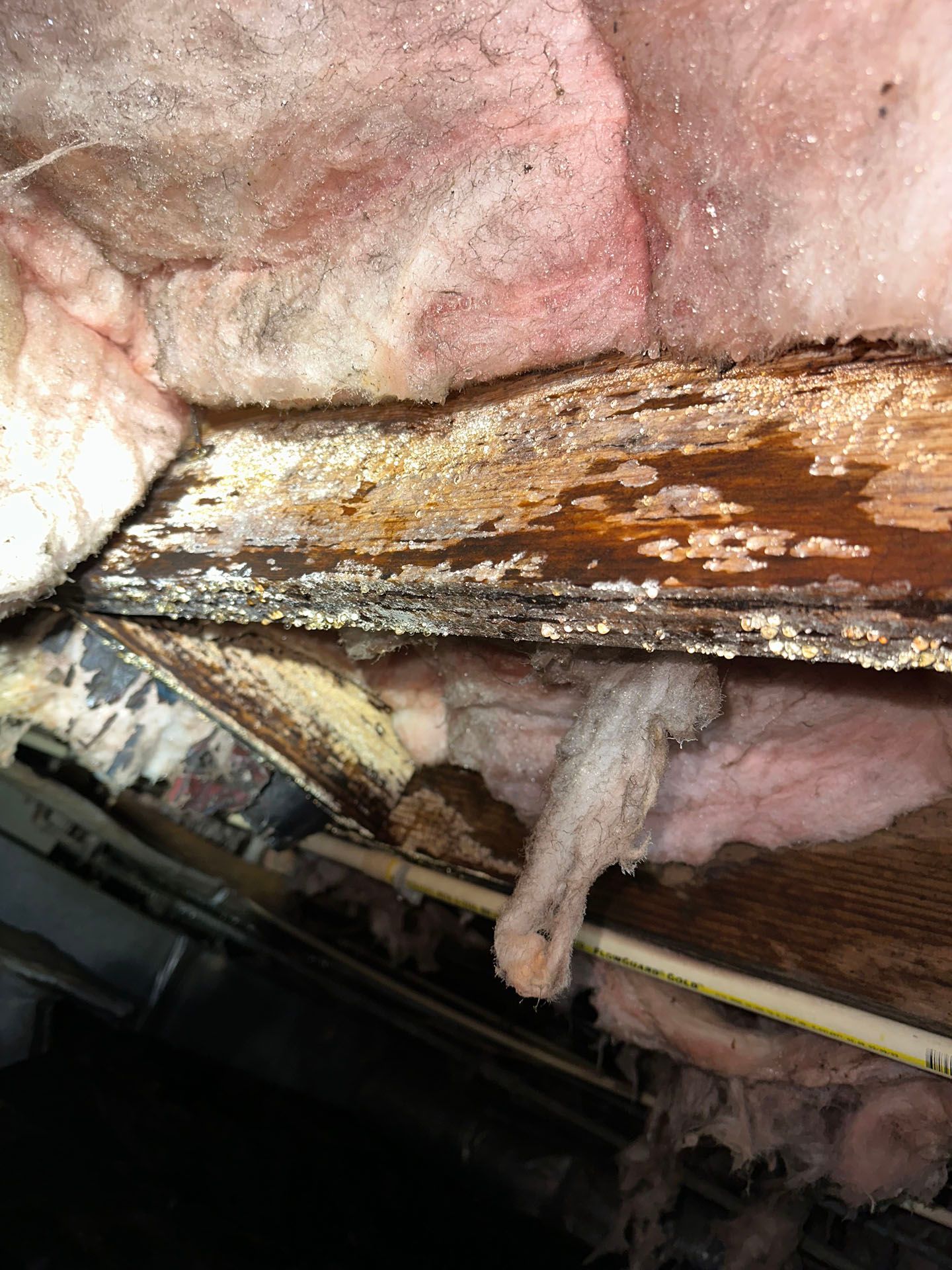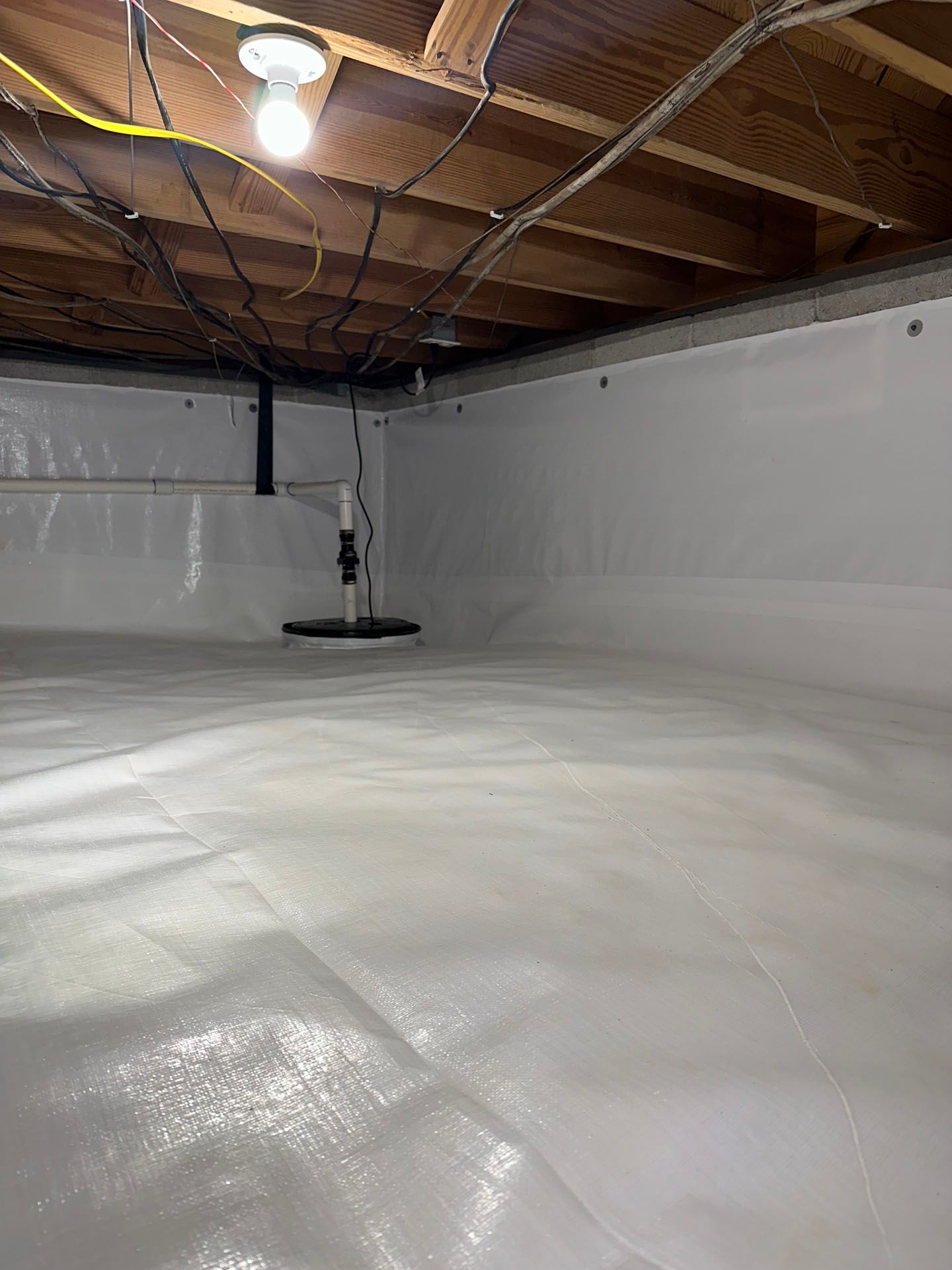Huntsville, Alabama

Claim Your FREE Crawl Space Inspection Today!
Sawyer Williams: 256-727-4422
Schedule Your Free estimate!
No-Obligation, Free Inspections
No-Obligation Free Estimates
We Warranty All of Our Work
100% Satisfaction Guaranteed
Do your allergy symptoms seem to kick up as soon as you enter your crawl space? Does the smell take you by surprise? Or have you noticed some dark, discolored patches popping up in a secluded corner of your home? If so, it's likely that you have a mold problem in your crawl space - and it's time to take action. But before you start reaching for the bleach and praying that the problem will vanish, it's important to understand the risks you face, the steps to take, and the best methods to actually eradicate mold once and for all. Today, we're discussing the ins and outs of dealing with mold in your crawl space - what you need to know, what you should have on hand, and how to put this pesky problem to rest for good!
Quick Explanation
The first step is to ensure adequate ventilation and reduction of moisture in your crawl space. Once the area is dry, use a mixture of bleach and water to clean the surface areas with mold present.
Identifying the Mold in Your Crawl Space
Identifying the mold in your crawl space is essential for taking appropriate action to remediate and prevent further growth. Visual inspection alone is not enough, as it can be difficult to accurately identify the kind of mould present. Careful inspection by a professional will likely be needed to differentiate between harmless and hazardous strains of mold.
When inspecting your crawl space, take note of any strange odors or visible signs of mold growth such as fuzzy patches on walls or floors. Even if these spots are absent, it may still be wise to have a professional inspect your home if you think there has been prolonged moisture exposure in the past. Signs of water damage often provide clues as to potential mold growth.
Testing should include air samples to determine whether mold spores are present and in what concentrations. Surface swab tests can also determine what types of mold are present on walls or surfaces. Lastly, tape lift tests can be used for samples from carpets or other fabric objects which may have been contaminated by mould.
Understanding the cause of any existing mould is important in determining an effective solution and preventing future growth. This requires careful analysis of current conditions in the crawl space, along with a detailed assessment of previous events that may have led to a mould infestation such as flooding, leaking pipes, and hvac condensation. In the next section we will cover the various causes of mould in crawl spaces, and how knowing their source can help you manage them effectively.
Understanding the Cause of Mold
Understanding the Cause of Mold is an important step in properly addressing a mold infestation in your crawl space. It is essential to identify the source of the mold in order to take the necessary steps to fully remediate it.
Mold spores occur naturally everywhere and can be found indoors when conditions are present for it to grow. These conditions include high humidity, a temperature between 40 and 100 degrees F, and a food source (cellulose). If present, these three things become conducive for mold growth.
There are many potential causes of high humidity in your crawl space such as poor ventilation, leaking pipes or ducts, inadequate drainage, or the presence of too much landscaping near the crawl space entrance. Poor ventilation that leads to stagnation of air can cause moisture to accumulate due to inadequate air exchange inside your crawl space as well.
The debate as to whether excessive levels of moisture can be attributed solely to ventilation issues is an ongoing one. On one side of the debate, people believe that poor ventilation plays a critical part in up-keeping ideal crawl space humidity levels and modern long-term solutions should include adequate amounts of crawl space ventilation as part of their approach. On the other side, others suggest that air quality should not be considered over-inflated and that proper installation techniques around creating vented wells and vents should be used instead when dealing with excess moisture levels.
Whichever side you may fall on, it is clear that understanding the cause of mold is an important step in addressing this issue. By doing so and taking necessary action based on its findings, you can ensure you’re mitigating any issues associated with reducing moisture levels in your crawl space. Now, let's move onto the next step: Is Reduced Ventilation an Issue?
Is Reduced Ventilation an Issue?
Reduced ventilation is an important factor to consider when dealing with mold in your crawl space. Adequate ventilation is necessary for dispersal of moisture and prevention of mildew and mold growth. Poor ventilation can lead to a humid environment, which can feed the growth of fungi. There are varying opinions on this topic, however.
On one hand, some experts suggest that controlling air flow is important and keeping your crawl space as sealed off as possible helps achieve this goal. On the other hand, others believe that ventilating a crawl space by allowing fresh outside air in can help keep dry conditions in the crawlspace and prevent moisture buildup.
Additionally, a balanced approach may be beneficial, allowing some forms of ventilation while creating barriers to stop extreme temperatures or damaging winds. It is important to discuss various options with a certified technician or professional prior to making any decisions regarding the installation of appropriate ventilation products.
The next section will discuss what is the moisture/humidity level in your crawl space and how it should be addressed if necessary.
Must-Know Summary Points
Sealing off the crawl space can help to prevent mold growth, but proper ventilation is also important to controlling moisture levels within the space. A balanced approach that incorporates some ventilation and temperature/wind barriers should be considered when discussing the installation of ventilation products with a professional technician. The moisture/humidity level in the crawl space should be addressed if necessary.
What is the Moisture/Humidity Level in Your Crawl Space?
Maintaining an optimum moisture/humidity level in the crawl space is an integral part of preventing mold from developing. Too much moisture can allow the environment to become a breeding ground for mold, while too little moisture can make it harder for the area to be modified and treated. It is important to remember that all materials - including wood, insulation, paper, cardboard - are more vulnerable to mold growth when exposed to high humidity levels.
Ideally, the relative humidity of your crawl space should not exceed 60%. To reach and maintain this specified level, you must first identify and address any moisture sources in the area. For example, if there’s a drainage issue around or outside your home that’s allowing water in, you need to figure out how to block it out and pipe away standing water. You may also need to install a dehumidifier or use a dehumidifier fan to extract any excess moisture from the air. Regularly ventilating the crawl space can also help reduce the relative humidity levels.
Moisture problems can be hard to identify and solve, but investing time into finding the source and treating it properly can help avoid any future mold issues.
With moisture levels in check, it is now time to move on to remediating the mold in your crawl space.
Remediating the Mold in Your Crawl Space
When dealing with mold in your crawl space, one of the most important steps is to remediating it. The first step is to identify what type of mold it is and how extensively it has invaded the area. To do this, you should hire a certified professional who can test for and identify the type of mold and determine if further action is needed.
The most common form of remediation is to use a combination of chemical cleaners and physical removal using high-powered vacuums. Chemical cleaners are effective in killing the spores on exposed surfaces, but because these cleaners cannot reach into cracks or deep within porous materials, physical removal or encapsulation may be necessary. When using chemical cleaners, safety precautions should be taken to avoid exposure and contamination; however, gloves and other protective equipment can help mitigate risks if known molds are present.
Physical removal generally entails encasing the affected material in plastic bags and removal from the area. If the material cannot be removed (e.g. insulation), then it must be encapsulated by creating a barrier around it that prevents spores from spreading. In some cases, full replacement of affected materials may be necessary.
When choosing to take on a remediation project, there are numerous factors to consider such as whether it’s safe to perform DIY work or if the job requires professional assistance. It’s important to weight out all options before deciding on a course of action as improper remediation can be costly and potentially dangerous if done incorrectly.
Having tackled the challenge of remediating the mold in your crawl space, now it's time to look at having a professional inspect and test the area for any lingering issues or unseen dangers as part of ensuring a complete solution for your mold problem.
Having a Professional Inspect & Test the Area
Having a professional inspect and test the area can help to identify the cause, location, and extent of mold growth. A reputable and certified mold inspector should be brought in to assess both physical and environmental parameters within the crawl space to accurately diagnose the issue. The inspector will test for moisture levels, temperature changes, visibility of mold (if present), dust sampling, and any other substances that may contribute to poor air quality or have an adverse effect on health.
Homeowners may debate whether or not the cost of engaging a professional is worth it. Professional home inspection services typically range from $200 - $500 depending on your area, while more specialized services such as mold testing can be twice as much. However, engaging an expert can provide invaluable insight into what actions need to be taken, as well as assurance that the job was done correctly. On the other hand, DIY testing carries some risk of incorrect analysis or failure to properly identify potentially harmful instances of mold infestation – all at no small expense.
Ultimately, it’s up to the homeowner's individual budget and situation when deciding whether or not to invest in professional assistance. Moving forward from this decision point, however, now is the time to look at cleaning and air quality testing options for your crawl space.
Cleaning & Air Quality Testing the Crawl Space
When it comes to dealing with mold in a crawl space, cleaning and air quality testing the area is key. When it comes to tackling the mold, there are two main approaches homeowners should consider: DIY solutions or professional mold removal services.
Let’s start with a DIY solution. If you decide to take on the challenge of ridding the crawl space of mold yourself, there are some important steps to follow:
1. Wear protective gear. Make sure to cover your body so that you don’t come into contact with the mold while scrubbing and cleaning the area. Wear a face mask and gloves as well as safety goggles to protect your eyes from any airborne particles caused by scrubbing/cleaning.
2. Isolate the area and open windows for ventilation. Be sure to contain or seal off any affected areas in order to prevent mold spores from traveled elsewhere throughout the home during cleaning. Open any windows or vents in order to provide proper ventilation throughout the process which will also lower humidity levels.
3. Clean surfaces using soap and water; Use a detergent if necessary to remove any tough residues caused by mold growth.
Once you've finished drying the surfaces, use an air quality testing device available at most hardware stores to measure air-quality levels in the crawl space after cleaning. This is important because it will help determine if more aggressive steps are needed, such as professional mold remediation service, or if you have successfully removed all visible traces of the fungi present in your home's atmosphere.
On the other hand, those who want to ensure their problem is completely taken care of might choose to hire a professional for remediating the crawling area instead of DIY solutions. Professionals will inspect and sample air from different parts of your home and identify any further issues that can be associated with problems in air quality due environmental causes like radon gas (which can increase risk for respiratory-related illnesses). The added layer of security might be worth investing in for some homeowners facing a major infestation or recurrent problems with mold growth in their crawl spaces.
Now that cleaning and air quality testing has been discussed, it’s time move onto reducing humidity and moisture levels which is essential when trying eradicate mold growth permanently in a crawl space.
- Inhaling or coming into direct contact with mold can lead to allergic reactions, asthma episodes and respiratory problems.
- Studies have shown that exposure to fungal spores (from molds) can be linked to a variety of chronic diseases such as migraines, memory loss, depression and fatigue.
- According to the American Academy of Allergy Asthma & Immunology, individuals with weakened immune systems may be at an increased risk of developing serious infections from mold.
Reducing Humidity and Moisture Levels
Reducing moisture and humidity levels in your crawl space is essential for protecting the health of your family and reducing mold risk. Controlling moisture and humidity levels requires careful attention to humidity sources, such as ventilation, ground water seepage, wet soil, and condensation.
One way to reduce moisture and humidity levels is by controlling the ventilation in your crawl space. Consider installing fans or vents to maintain airflow in your crawlspace and keep the area from getting too humid. These systems must be checked regularly to ensure proper functioning, and be sure to clean any air filters regularly to minimize airborne mold spore exposure.
Adding a dehumidifier may also help reduce humidity, especially during humid months like summer when moisture can accumulate quickly. A dehumidifier is a great solution if you want to maintain optimal indoor humidity levels without having to pay for expensive repairs or replacements. However, it should be noted that a dehumidifier will increase energy costs as they require power to operate.
Using vapor barriers on walls, floors, and ceilings is another measure you can take to reduce moisture levels. Vapor barriers trap moisture within the walls of your crawl space, preventing it from entering the living areas of your home. The installation of vapor barriers should always be done according local building codes and recommended practices by both OSHA and EPA standards.
Finally, addressing any water sources or leaks can go a long way in preventing moisture buildup in your crawl space. Invest in quality sump pumps if necessary or contact a professional waterproofing team like HomePro Services | Sullivan Roof & Exteriors to inspect for underlying issues with flooding.
With these tips for reducing humidity and moisture levels in mind, we can now move on to discussing how to mitigate health & environmental issues caused by mold growth in your crawl space.
Mitigating Health & Environmental Problems
When dealing with mold in a crawl space, mitigating health and environmental problems is of the utmost importance. Mold in the home can cause numerous health issues such as allergic reactions, asthma and other respiratory issues, headaches, dizziness, skin rashes and more. High moisture levels in a dark and damp location like a crawl space are especially conducive to mold growth.
The key to mitigating these health risks is preventing additional moisture from entering the area and removing any wet materials that might be contributing to the excessive moisture levels. Identifying the specific source of the moisture should take priority as it may require something beyond surface solutions like using fans or dehumidifiers. If water damage or leaks are present, they need to be addressed first and foremost before any real progress will be made.
If all potential problems have been identified and stopped or addressed then one can proceed to reducing ambient moisture levels through solutions like dehumidifiers, fans or ventilation techniques. The majority of cases will see significant improvement once this is accomplished. The next step would be to remove any mold presence if one has already formed by properly disposing of all affected surfaces material.
To finish up the mitigation process it is best to use a combination of routine maintenance methods incorporating preventative solutions that help stave off new issues from developing like keeping humidity levels low and daily inspections for leaks or changes in water pressure/conditions.
Since proper safety precautions need to be taken before attempting to resolve a mold problem in a crawl space it is recommended to move on now to the section discussing taking safety precautions before proceeding.
Taking Safety Precautions Before Proceeding
Taking safety precautions is an essential step when it comes to dealing with mold in a crawl space. Before proceeding, it's important to protect yourself from any potential health risks that come from working with or around mold.
First and foremost, wear proper protective clothing like long pants and sleeves and a respirator or facemask for extra protection. N-95 respirators and facemasks are effective at filtering out mold spores that can be hazardous to breathe in. To be safe, make sure the clothing you use is washable so that it can be properly cleaned after your work has been completed.
Some people argue that they don't need to wear any protective clothing when dealing with mold since their immune system can handle it. However, while it is true that some people may have a higher tolerance than others, wearing protective clothing ensures that everyone is protected, regardless of one’s individual level of immunity. Moreover, some types of mold can cause serious respiratory illnesses if not handled correctly.
In addition to wearing protective clothing, you should also consider using mouldicides or other anti-mould products when dealing with mould in your crawl space. These products help to kill any existing mould in the area and prevent further growth in the future. Make sure you read all safety instructions before using these products and never mix chemical or products together without first consulting an expert.
Finally, you should always keep an eye out for signs of structural damage, such as sagging ceilings or walls, wet insulation or warped wood, as these could all signal a more serious problem with structural integrity of the crawl space. In this instance, you should contact a professional for further assessment and advice on how to proceed.
Overall, taking the time to take the appropriate safety precautions when dealing with mould in a crawl space is essential in order to ensure everyone’s safety and wellbeing throughout the process. By following these steps, you can protect yourself and your family from any potential health hazards associated with handling mould in confined spaces.
Frequently Asked Questions Answered
What preventative steps can I take to avoid mold growth in my crawl space?
There are several preventive steps you can take to avoid mold growth in your crawl space. First, make sure that your crawl space is well-ventilated by installing at least one fan or window in the area. This will help keep the humidity level low, which is important since mold thrives in moist environments. Secondly, if you have any pipes or water lines running through the crawl space seal up any leaking joints and ensure all water lines are insulated properly.
Finally, be sure to monitor the moisture levels regularly to make sure there isn't any accumulation of moisture in the space. If needed, consider running a dehumidifier in the crawl space to keep the humidity levels under control. By following these simple steps, you can help prevent mold from taking hold in your crawl space and save yourself from a lot of costly repairs down the line.
What should I do if I find mold in my crawl space?
If you find mold in your crawl space, the first step is to take action immediately. The faster you act, the better off you will be in the long run. First, identify any sources of moisture that may be contributing to the growth of the mold. This could include plumbing leaks, condensation, or other sources of water. Once these sources have been located and dealt with, proceed with cleaning up the affected area by removing any visible mold growth and thoroughly drying the area.
Next, apply a detergent solution to the affected areas and scrub it down. This will help to loosen and remove any remaining mold spores which may be stuck on walls or other surfaces. Be sure to wear protective clothing and equipment when handling this as some types of molds can become airborne during removal. Afterward, use a damp cloth or mop to get rid of all the debris.
Finally, make sure that the area is well-ventilated going forward to prevent future mold growth and make sure to keep inspecting your crawlspace regularly for any signs of suspicious activity. Following this process can help keep your crawl space clean and free from harmful mold infections.
What are the potential health risks associated with mold in a crawl space?
The potential health risks associated with mold in a crawl space are quite serious. The most common health risks include respiratory issues, such as asthma and other allergies, eye irritation and skin irritation. Additionally, exposure to certain types of mold can lead to more severe symptoms including headaches, nausea, insomnia and even fever.
Furthermore, long term exposure to mold in a crawl space can lead to more severe illnesses such as anxiety, depression or even neurological damage or cancer. People with already existing lung or breathing issues may be particularly vulnerable to these health risks, as the spores can irritate their lungs and cause further complications.
It is important to note that not all molds are toxic; however, it is impossible to tell which molds are benign and which could cause serious harm without proper testing from a professional. It is best to use caution when dealing with any kind of mold growth and contact a specialist if needed.
What are the best ways to effectively remove mold from a crawl space?
The best way to effectively remove mold from a crawl space is to use an appropriate combination of mechanical and chemical cleaning methods. Mechanical cleaning methods include vacuum cleaning with a HEPA-rated vacuum, dry brushing, and scrubbing with a stiff brush. Chemical cleaning methods involve the use of fungicides and other detergents.
Vacuuming with the right type of vacuum is essential in removing the large majority of visible mold growths. It is important to use a HEPA-rated vacuum that can properly handle large amounts of dust and debris. If possible, set up fans to aid in the removal process since it helps to circulate the air.
Dry brushing and scrubbing are also helpful for removing stubborn mold growths. Using a stiff brush, lightly scrape away any remaining debris as much as possible before applying the chemical cleaner. This will ensure that the chemical cleaner can get to the root of the mold problem.
Chemical cleaners are then used to remove any remaining mold spores or prevent them from returning. Make sure to read labels carefully and follow directions explicitly when applying the chemicals and wear protective gear when handling these products. After application, allow enough time for the cleaner to dry completely before using fans or other ventilation systems in order to restrict cross contamination with other areas within your home.
Combining mechanical and chemical methods will help you safely remove mold from your crawl space and prevent future outbreaks.
Key Questions:
1. What is mold and what health effects can it have?
Mold is an airborne fungus that can grow and spread in areas with high moisture, such as a crawl space. It can cause a variety of health effects, including respiratory problems, eye and skin irritation, headaches, fatigue, and other allergic reactions. Long-term exposure to mold can also lead to more serious conditions such as asthma or chronic sinus infections.
2. How do I prevent mold from forming in my crawl space?
Mold growth in a crawl space can be prevented by controlling moisture levels. This includes making sure that your crawl space stays dry by ensuring proper drainage and removing any standing water; sealing foundation cracks; eliminating condensation; ventilating the area with fans or dehumidifiers; controlling humidity levels; and addressing any underlying water damage or leaks. Additionally, it's important to maintain good indoor air quality by regularly cleaning and changing air filters, adhering to proper insulation standards, and avoiding items like carpeting or musty furniture that could foster the growth of mold.

Written by Sawyer Williams
Precision Crawlspace & Renovations
Sawyer has specialized in crawl space and foundation repairs for over six years. As the founder of Precision Crawlspace and Renovations, he is one of Huntsville's top experts in crawlspace moisture control. He has prior experience installing these systems, which has prepared him to solve complex problems related to crawl space encapsulation, mold remediation, and waterproofing.
Recent Blog Posts
Huntsville's Crawl Space News



What are you waiting for?
We Solve Crawl Space Issues!
Get reliable crawl space repair services at an affordable price, provided with the high level of service you deserve.
Call Us Today at: 256-727-4422
All Rights Reserved | Precision Crawlspace & Renovations

